
Concept explainers
a.
To draw: A
a.
Answer to Problem 11PPS
Explanation of Solution
Given: State fair : Refer to the beginning of the lesson, it gives the following table for the attendance at the state fair.
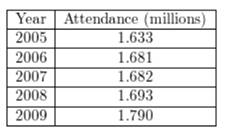
Calculation:
To graph a scatter plot of the data ,where x =1 represents 2005.then the table becomes,
| Year x | 1 | 2 | 3 | 4 | 5 |
| Attendance (millions) y | 1.633 | 1.681 | 1.682 | 1.693 | 1.790 |
To use the above data and a graphing calculator the linear regression equation is,
Graph this equation on scatterplot.
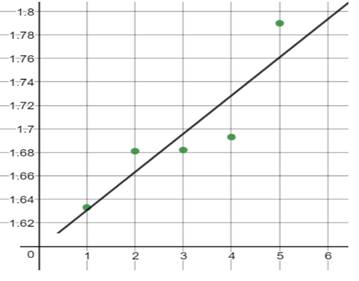 ..
..
b.
To draw: A graph and analyze the residual plot.
b.
Answer to Problem 11PPS
The residuals are randomly scattered above and below the x -axis so the regression equation fits the data well. Regression model is a good fit for the data.
Explanation of Solution
Given: State fair :Refer to the beginning of the lesson, it gives the following table for the attendance at the state fair.
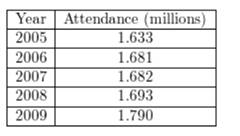
Calculation:
To graph a scatter plot of the data ,where x =1 represents 2005.then the table becomes,
| Year x | 1 | 2 | 3 | 4 | 5 |
| Attendance (millions) y | 1.633 | 1.681 | 1.682 | 1.693 | 1.790 |
To use the above data and a graphing calculator the linear regression equation is,
Graph the residuals plot. The residuals are randomly scattered above and below the x -axis so the regression equation fits the data well.
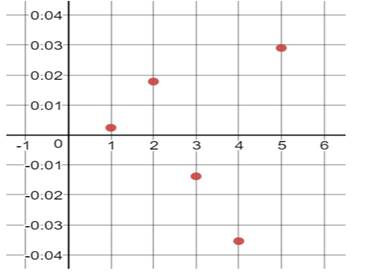
c.
To predict: The total attendance in 2025.
c.
Answer to Problem 11PPS
2.28 million people, Yes.
Explanation of Solution
Given: State fair :Refer to the beginning of the lesson, it gives the following table for the attendance at the state fair.
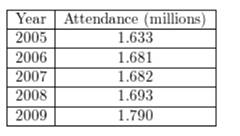
Calculation:
Conclusion:
2025 is 20 years after 2005 so we need to find y -value for x= 21(since x =1 represents 2005)on our graph of linear regression.
Put x= 21 in linear regression equation ,
So, the predicted attendance in 2005 is 2.28 million people. This prediction is reasonable since it is not drastically larger than the attendance in the table. The
Chapter 4 Solutions
Algebra 1, Homework Practice Workbook (MERRILL ALGEBRA 1)
Additional Math Textbook Solutions
Thinking Mathematically (6th Edition)
Elementary Statistics (13th Edition)
Elementary Statistics: Picturing the World (7th Edition)
College Algebra with Modeling & Visualization (5th Edition)
- 8) Solve the given system using the Gaussian Elimination process. 2x8y = 3 (-6x+24y = −6arrow_forward7) Solve the given system using the Gaussian Elimination process. (5x-4y = 34 (2x - 2y = 14arrow_forward33 (a) (b) Let A(t) = = et 0 0 0 cos(t) sin(t) 0-sin(t) cos(t)) For any fixed tЄR, find det(A(t)). Show that the matrix A(t) is invertible for any tЄ R, and find the inverse (A(t))¹.arrow_forward
- Use the infinite geometric sum to convert .258 (the 58 is recurring, so there is a bar over it) to a ratio of two integers. Please go over the full problem, specifying how you found r. Thank you.arrow_forwardH.w: Find the Eigen vectors for the largest Eigen value of the system X1+ +2x3=0 3x1-2x2+x3=0 4x1+ +3x3=0arrow_forwardneed help with 5 and 6 pleasearrow_forward
- 1) Given matrix A below, answer the following questions: a) What is the order of the matrix? b) What is the element a13? c) What is the element a₁₁? 4 -1arrow_forward[25 points] Given the vector let v = ER² and the collection of vectors ε = E-{)·()}-{☹) (9)} = {(A)·(9)}· B: = and C = · {(6)·(})}· answer the following question. (a) (b) (c) (d) (e) verify Verify is a basis for R² and find the coordinate [] of under ε. Verify B is a basis for R2 and find the coordinate []B of ʊ Verify C is a basis for R2 and find the coordinate []c of under ε. under ε. Find the change-of-basis matrix [I]+B from basis B to basis ε, and EE+BUB Find the change-of-basis matrix [I]B+ε from basis Ɛ to basis B, and verify [U]B= [] B+EVEarrow_forwardExplain the following terms | (a) linear span (b) dimension of vector space (c) linearly independent (d) linearly dependent (e) rank of matrix Aarrow_forward
- 3. Let u = 3/5 √ = and = -4/5 -() Define V span{ū, }. (a) (b) (c) Show that {u, } is orthonormal and forms a basis for V. Explicitly compute Projy w. Explicitly give a non-zero vector in V+.arrow_forwardIs 1.1 0.65 -3.4 0.23 0.4 -0.44 a basis for R3? You must explain your answer 0arrow_forwardFind the values of x and y in the following scalar multiplication. 8 2 x 1 3 || y = 9 LY_ Show Calculatorarrow_forward
 Algebra and Trigonometry (6th Edition)AlgebraISBN:9780134463216Author:Robert F. BlitzerPublisher:PEARSON
Algebra and Trigonometry (6th Edition)AlgebraISBN:9780134463216Author:Robert F. BlitzerPublisher:PEARSON Contemporary Abstract AlgebraAlgebraISBN:9781305657960Author:Joseph GallianPublisher:Cengage Learning
Contemporary Abstract AlgebraAlgebraISBN:9781305657960Author:Joseph GallianPublisher:Cengage Learning Linear Algebra: A Modern IntroductionAlgebraISBN:9781285463247Author:David PoolePublisher:Cengage Learning
Linear Algebra: A Modern IntroductionAlgebraISBN:9781285463247Author:David PoolePublisher:Cengage Learning Algebra And Trigonometry (11th Edition)AlgebraISBN:9780135163078Author:Michael SullivanPublisher:PEARSON
Algebra And Trigonometry (11th Edition)AlgebraISBN:9780135163078Author:Michael SullivanPublisher:PEARSON Introduction to Linear Algebra, Fifth EditionAlgebraISBN:9780980232776Author:Gilbert StrangPublisher:Wellesley-Cambridge Press
Introduction to Linear Algebra, Fifth EditionAlgebraISBN:9780980232776Author:Gilbert StrangPublisher:Wellesley-Cambridge Press College Algebra (Collegiate Math)AlgebraISBN:9780077836344Author:Julie Miller, Donna GerkenPublisher:McGraw-Hill Education
College Algebra (Collegiate Math)AlgebraISBN:9780077836344Author:Julie Miller, Donna GerkenPublisher:McGraw-Hill Education





